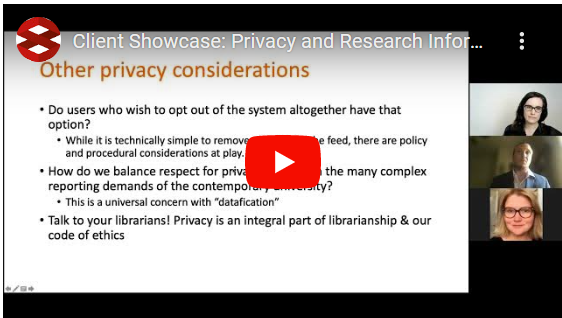Organisations seeking to select the right Research Information Management (RIM) System for them increasingly need to take into account issues around data privacy as part of the procurement process.
A 2019 report by University of California Senate warned of the “significant threat Research Information Management systems pose if not regulated by strong data governance,” and recommended that universities set strict policies on “data generated about faculty, addressing their ownership, collection and reuse.”
Oklahoma State University (OSU) recently adopted Symplectic Elements as a Research Information Management (RIM) System, which is being implemented and supported by the OSU Libraries. At a recent user meeting we heard from Clarke Iakovakis and Megan Macken of OSU Libraries on their decision-making process when selecting Symplectic Elements as a Research Information Management System.

Macken and Iakovakis also recently co-authored a paper on Privacy and Research Information Management Systems, published by Taylor & Francis in the March 8, 2021 issue of Serials Librarian and openly available as an accepted manuscript on the SHAREOK Repository here.
In the paper, Macken and Iakovakis note that, “During the exploratory phase, questions about user privacy and data ownership were at the forefront of our investigation of various RIM Systems.” Questions were raised about privacy concerns at both an institutional and an individual user level (usually faculty, researchers, or administrators working on their behalf), as profiles within Symplectic Elements can display a wide range of user information, including research outputs, collaborators, contact information, streaming media, citations and bibliometrics, and links to other repositories and permanent identifiers.
“University administrators and many faculty consider this ability to share personal data publicly an incredibly useful service. A RIM System provides a single authoritative profile within the university domain, a clear improvement over the myriad, free profile systems available around the web. In training sessions, early adopters or “Power Users” expressed excitement about the system. An important difference between previous iterations of faculty profile systems and websites and a RIM System, however, is that the traditional directory or CV data now appears alongside altmetrics and journal impact metrics that quantify faculty output at a glance….Despite significant research and international proclamations questioning the validity of tying bibliometric indicators to performance, these metrics continue to play a key role in tenure and promotion decisions; thus their inclusion in the system is not entirely unproblematic.”
Symplectic Elements is designed to offer granular controls over what personal data is available, both for their overall profile and for specific profile components. Components can be individually set as either ‘Public’ (for institutions which have developed a public portal using the Discovery Module, such as OIEX); ‘Private’ (available to other institutional users), or ‘Private’ (available only to the user, the user’s selected delegates, and administrators).
“The Digital Science Representatives were very responsive to all of these concerns and all of them were addressed to the point that we felt very comfortable moving forward with Elements,” concluded Iakovakis during the Symplectic 2021 User Meeting.
